

The_EEF_guide_to_supporting_school_planning_-_A_tiered_approach_to_2021. Tracking progress: collecting and analysing data. The Key for School Leaders. School inspection data summary report (IDSR) guide. Overview of the IDSR: This guide is for primary and secondary IDSRs.
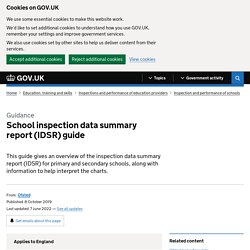
5 Models for Leading Change. Read in 6 minutes In this article we briefly introduce 5 models for leading change within the organisation.
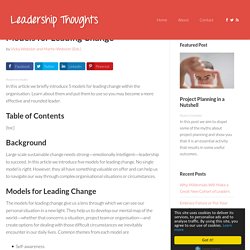
Learn about them and put them to use so you may become a more effective and rounded leader. Table of Contents [toc] Background. 4 Things Successful Change Leaders Do Well. We know that two-thirds of large scale transformation efforts fail.

But that’s not a terribly helpful piece of information―unless we’re looking for confirmation that this is hard, really hard. What is useful is to understand what leaders can do to substantially increase the odds that their companies won’t be among the two-thirds of those that fail. From my research and work with companies around the world leading large-scale transformation initiatives, here are the four things I’ve found that virtually all successful change leaders do really well: Recognize embedded tensions and paradoxes Smart, capable, solid professionals most often perform well in their roles until they reach a level in their organizations at which they are confronted with a series of embedded tensions and paradoxes that make leading effectively much more complicated. Revitalization vs. Successful transformation leaders embrace these tensions even though they make the challenge more complex. Hold everyone accountable. The_EEF_guide_to_supporting_school_planning_-_A_tiered_approach_to_2020-21.
Families of Schools Database. Putting Evidence to Work - A School’s Guide to Implementation. Schools are learning organisations. They continuously strive to do better for the children and young people in their charge. In doing so, they try new things, seek to learn from those experiences, and work to adopt and embed the practices that work best. Implementation is a key aspect of what schools do to improve, and yet it is a domain of school practice that rarely receives sufficient attention.
In our collective haste to do better for pupils, new ideas are often introduced with too little consideration for how the changes will be managed and what steps are needed to maximise the chances of success. Too often the who, why, where, when, and how are overlooked, meaning implementation risks becoming an ‘add on’ task expected to be tackled on top of the day-to-day work. One of the characteristics that distinguishes effective and less-effective schools, in addition to what they implement, is how they put those new approaches into practice.
Handbook and competency framework. These guides are for: governing boards in local-authority-maintained schools boards of trustees in academies others involved in school governance, such as sponsors, foundations and dioceses organisations that help governing boards be more effective, such as governance training providers anyone providing clerking services to a governing board The ‘Governance handbook’ explains: governing boards’ roles and functions their legal duties where they can find support the main features of effective governance.

School inspection handbook. Skip to main content GOV.UK uses cookies which are essential for the site to work.
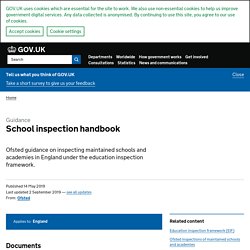
We also use non-essential cookies to help us improve government digital services. Any data collected is anonymised. By continuing to use this site, you agree to our use of cookies. Cookie settings You’ve accepted all cookies. Close Tell us what you think of GOV.UK Take a short survey to give us your feedback We’ll send you a link to a feedback form. Don’t have an email address? Thanks, we’ve sent you an email with a link to the survey. Sorry, we’re unable to send you an email right now. Home. 8 Steps for an Effective Change Management Process. 8 Essential Steps for an Effective Change Management Process Your organization is constantly experiencing change.

Whether caused by new technology implementations, process updates, compliance initiatives, reorganization, or customer service improvements, change is constant and necessary for growth and profitability. A consistent change management process will aid in minimizing the impact it has on your organization and staff. Kotter's 8-Step Change Model - Change Management Tools from Mind Tools.
"Change is the only constant.
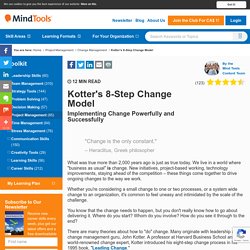
"– Heraclitus, Greek philosopher What was true more than 2,000 years ago is just as true today. We live in a world where "business as usual" is change. New initiatives, project-based working, technology improvements, staying ahead of the competition – these things come together to drive ongoing changes to the way we work. Whether you're considering a small change to one or two processes, or a system wide change to an organization, it's common to feel uneasy and intimidated by the scale of the challenge.
You know that the change needs to happen, but you don't really know how to go about delivering it. There are many theories about how to "do" change. In this article, video and infographic, we look at his eight steps for leading change, below. Click here to view a transcript of this video. School workload reduction toolkit. How to use the toolkit The resources in this toolkit have been produced by school leaders, teachers and other sector experts in conjunction with the Department for Education (DfE), and have been tested with a range of schools across England.
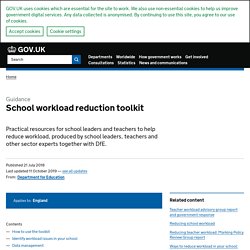
You can use these resources to: identify workload issues in your school address workload issues in your school (such as feedback and marking) evaluate the impact of workload reduction measures. Workload Advisory Group report.